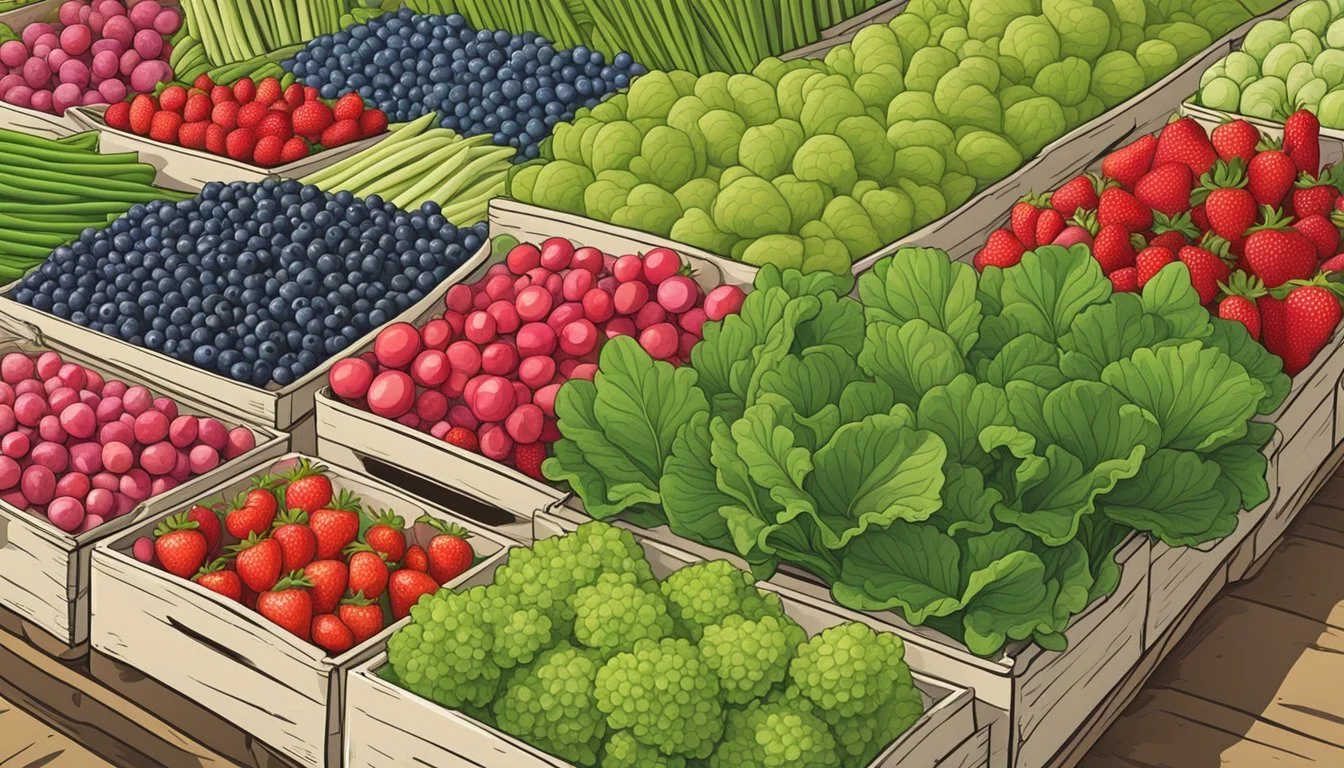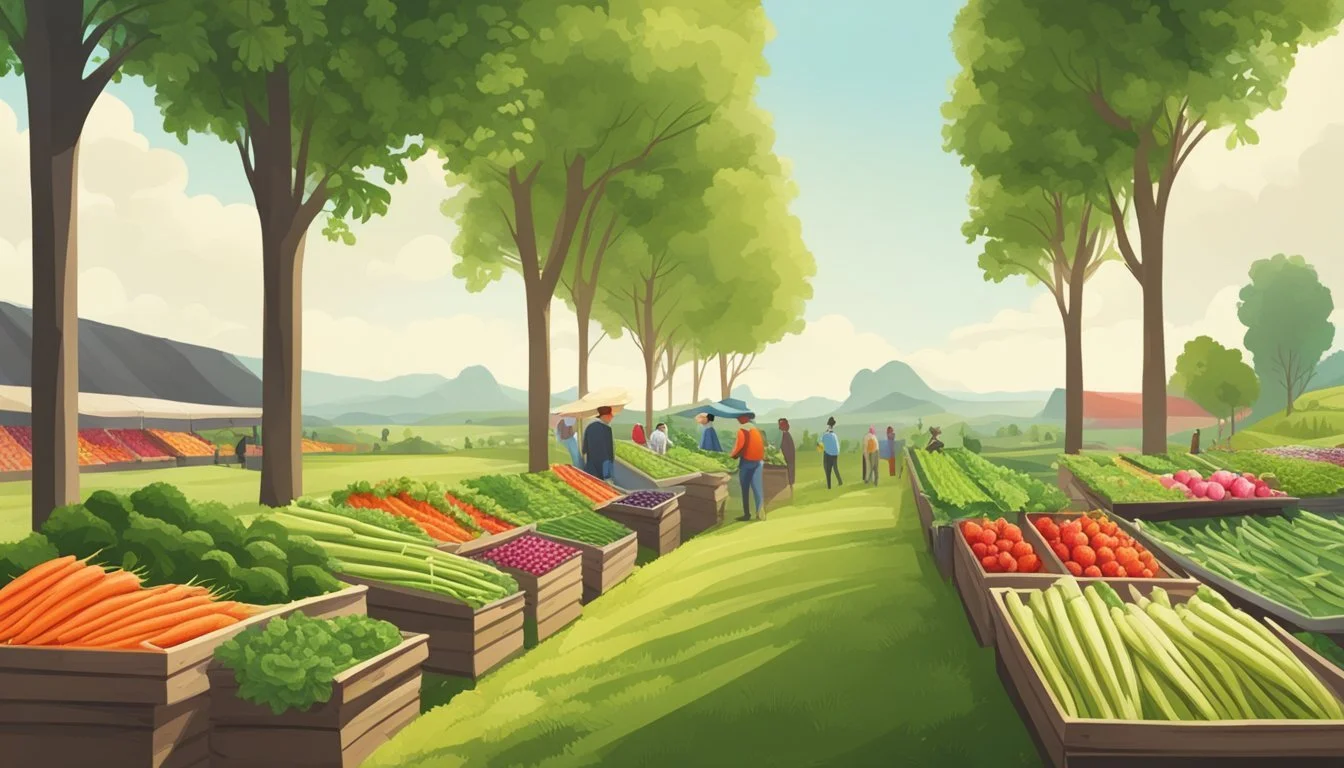New Hampshire Seasonal Fruit & Vegetables in April
Your Shopping Guide
This Article is Part of our New Hampshire Seasonal Fruit & Veg Calendar
In the transitional month of April, New Hampshire gardens begin to wake from their winter slumber. This period marks a time when the earliest spring crops start to become available. Root vegetables and some hearty greens that have been overwintered often make their appearance in the local markets and provide a prelude to the abundance of fresh produce that will follow with the warmer months.
They can expect a selection of produce that thrives in the cool, damp climate of early spring in New England. While the variety of local fruits is still limited, the selection of vegetables begins to expand. Greens like spinach and kale may be harvested, and cold-hardy vegetables such as radishes and peas begin to sprout.
As gardening enthusiasts and local farmers prepare the soil for the upcoming growing season, they also offer the last of the storage crops from the previous year. This includes items such as potatoes and onions, which remain staples until the new crops become plentiful. Consumers who are eager for fresh, local ingredients look forward to what April in New Hampshire has to offer, even as they anticipate the greater variety that will come with May and beyond.
Understanding New Hampshire's Growing Seasons
New Hampshire's growing seasons are defined by the cold Northeast climate of the United States, characterized by distinct spring, summer, fall, and winter periods. Spring in New Hampshire begins in late March and extends through May, marking a transitional period of thaw and gradual warming. This period often involves the preparation of soil and the planting of early crops that can tolerate cooler temperatures.
As summer arrives, typically from June through August, the state experiences its peak growing season. This is when the majority of the fruits and vegetables reach their optimal growth due to longer daylight hours and warmer temperatures. Summer harvests include a wide variety of produce, with availability at its highest during these months.
Fall in New Hampshire starts in September and runs into November. This season is known for its robust harvest, as the climate cools and crops that prefer lower temperatures begin to thrive. It's a time when root vegetables and certain fruit varieties reach maturity and are harvested.
Winter starts in December and lasts through February. During this period, the number of locally grown crops reduces significantly, with most available produce consisting of storage crops such as root vegetables or those that are greenhouse-grown.
April falls in the early growing season, which in New Hampshire is still predominated by the tail end of winter. The availability of regionally grown produce is minimal, primarily limited to storage crops and greenhouse offerings. As such, the harvest during April does not yet mirror the abundance found in the summer months. However, the planning and planting activities initiated in April set the stage for the successive bountiful seasons.
Month Season Availability April Spring Limited May Spring Improving June Summer Abundant July Summer Abundant August Summer Peak September Fall Robust October Fall Harvesting November Fall Winding down December Winter Sparse February Winter Minimal
Residents of New Hampshire adapt their consumption patterns and agricultural practices accordingly, to align with these cyclic changes in climate and crop availability.
April's Seasonal Produce Highlights
April in New Hampshire signals the awakening of local agriculture, leading to a selection of fresh produce that begins to flourish after the winter months. The onset of spring encourages the growth of several fruits and vegetables that are prime for harvest during this period.
Vegetables:
Asparagus (how long does asparagus last?) emerges as a star vegetable in April, known for its tender and flavorful spears. Enthusiasts can enjoy this vegetable steamed, grilled, or incorporated into a variety of dishes.
Rhubarb, though often used in sweet treats like pies, technically qualifies as a vegetable. Its tart stalks begin to be readily available and can provide a sharp, tangy flavor to recipes.
Greens:
A variety of leafy greens are ready to be picked, with their crisp texture and nutrients making them ideal for spring salads.
Root Vegetables:
Parsnips continue to be available into April, offering a sweet, earthy flavor that enhances many comfort dishes.
Availability Chart:
Fruit Availability Rhubarb April - Early June
Vegetables Availability Asparagus April - June Parsnips April; Oct - Dec
Shoppers are encouraged to support local New Hampshire farms and markets, where they can obtain these seasonal offerings at the peak of freshness. As the month progresses, one can anticipate more variety as other fruits and vegetables enter their prime season.
Spring Vegetables Available in April
As April ushers in the spring season in New Hampshire, a variety of fresh vegetables begin to make their appearance in local markets. The warming soil and increasing daylight provide ideal conditions for the first harvests of leafy greens, root vegetables, and seasonal legumes.
Leafy Greens and Herbs
During April, leafy greens flourish, offering a fresh taste of spring after the winter months. Consumers can find a variety of greens for their salads and cooking needs:
Spinach: Tender and versatile, ideal for salads and sautéed dishes. (What Wine Pairs Best with Sautéed Dishes)
Lettuce: Crisp and fresh, including varieties such as Romaine and leaf lettuce.
Arugula: With its peppery flavor, it's a great addition to salads and sandwiches.
Chard: Rich in color and nutrients, chard can be sautéed or added to soups.
Kale: Hardy and nutrient-dense, perfect for salads and chips.
Cabbage: A staple in slaws and ferments like sauerkraut (how long does sauerkraut last?).
Fresh herbs (how long do fresh herbs last?) also start to become more readily available, enhancing flavors in a wide range of recipes.
Root Vegetables and Stems
Root vegetables that have wintered well in the ground are typically ready for harvest:
Radishes: These crisp, spicy treats are often available in April.
Turnips: Their earthy taste and versatility make them a great addition to spring meals.
Additionally, some stem vegetables such as fiddleheads might be found in local markets, though these are often foraged rather than farmed.
Seasonal Legumes
Early legumes begin to make an appearance in the garden:
Peas: Sweet and crisp, they are often best enjoyed fresh from the pod.
Fava beans: (how long do fava beans last?) Although not as common, these can be found and are treasured for their buttery texture and slightly nutty flavor.
These legumes add both protein and a burst of spring flavor to any dish they accompany.
Seasonal Fruits to Enjoy
April in New Hampshire marks a transition in produce offerings, as winter storage dwindles and early spring fruits begin to appear. Although the variety is not as abundant as in summer months, shoppers can still find some fresh, seasonal fruits to enjoy.
Early Spring Berries
At the outset of spring, berries are not yet at their peak in New Hampshire. Due to the state's climate, berry growth is slower and typically does not begin until late spring or early summer. However, one might find fiddleheads—not a berry, but a fern that is often grouped with early spring produce—appearing in markets.
Orchard Offerings
The hallmark fruit of early spring is rhubarb, which is often used in pies and jams. While not a fruit from the orchard, rhubarb's tartness is a welcome precursor to the sweeter fruit to come. Apples from cold storage, such as keeper varieties, are still available in April, offering crispness and a range of flavors from the last harvest. Fresh apples will not be picked until later in the year, but these stored apples still provide quality and taste.
Preparing and Cooking April Produce
April in New Hampshire heralds the arrival of early spring produce. The following are some tips and methods suitable for preparing and cooking the fresh, local produce available during this month.
Root Vegetables:
Parsnips: They can be roasted to enhance their natural sweetness. Simply peel, slice, and toss them with olive oil, salt, and a touch of honey before roasting until golden.
Carrots: They offer a robust flavor when glazed. Cook sliced carrots in a pan with butter, sugar, and a little water until tender and caramelized.
Leafy Greens:
Spinach: This leafy green wilts rapidly; a quick sauté with garlic in olive oil retains its flavor and nutrient content.
Kale: For kale, massaging the leaves with a dressing can soften them for a flavorful salad.
Flowering Vegetables:
Broccoli: Its florets are ideal for steaming or stir-frying. To maintain its vibrant green color, it should be cooked briefly until just tender.
Herbs:
Chives and Parsley: These herbs are best used fresh, chopped finely, and sprinkled over dishes before serving to preserve their delicate flavor.
Produce Preparation Method Cooking Suggestion Parsnips Peel and slice Roast with honey Carrots Slice Glaze or roast Spinach Clean and pat dry Sauté quickly Kale Remove stems Massage, sauté, or bake Broccoli Separate into florets Steam or stir-fry Chives, Parsley Chop Use as garnish
Local, seasonal ingredients not only bring a burst of flavor to the table but also support sustainable agriculture. When cooking April produce, chefs often aim for methods that enhance and respect the fresh flavor of each item.
Where to Find Local Produce
In April, New Hampshire residents have several options for sourcing local produce. They can explore farmers' markets, join a CSA, or visit local grocers that prioritize stocking items from the region.
Farmers' Markets
Farmers' markets are a hub for fresh, regional offerings. In New Hampshire, many markets open in the spring and provide a variety of seasonal produce. Shoppers can expect to find early spring vegetables along with some greenhouse-grown produce. To find a market near you, the New Hampshire Department of Agriculture maintains a list of local farmers' markets.
Community-Supported Agriculture (CSA)
CSA programs are excellent for obtaining a regular supply of local fruits and vegetables. Participants purchase a share of the harvest from nearby farms, receiving a box of seasonal produce typically on a weekly basis. This initiative connects consumers directly with their food source and supports New Hampshire farmers. Interested individuals should sign up early as shares are often limited.
Local Grocers
Select local grocers specialize in providing produce sourced from New Hampshire farms. These establishments often label the origin of the produce, allowing consumers to easily identify and purchase local goods. They offer a reliable, year-round source for seasonal fruits and vegetables grown within the state.
Benefits of Eating Seasonally
When individuals choose seasonal produce, they reap numerous advantages related to health and community welfare. Produce harvested in its prime season is at its peak of freshness. This ensures that the vegetables and fruits are not only crisper and juicier but are also packed with their full spectrum of nutrients.
Appreciating seasonal foods ties directly to superior flavor. For example, strawberries and tomatoes grown and enjoyed in their natural growing season have distinctly richer and fuller tastes compared to those that are off-season and shipped from afar. Local farms in New Hampshire tend to harvest produce at the perfect time for consumption, ensuring that fruits and vegetables maintain their authentic flavor profiles.
Choosing to support local agriculture by consuming seasonal items contributes to the local economy and reduces the environmental footprint by minimizing the need for transportation. This helps to build a sustainable community and maintain a balanced ecosystem.
Incorporating seasonal produce into one’s diet also encourages a diverse range of foods throughout the year, fostering a varied and balanced diet. This diversity not only contributes to overall health but may also reduce the risk of developing certain diseases.
Season Produce Examples Benefit Spring Asparagus High in fiber Rhubarb Rich in antioxidants Peas Good source of vitamins A and C
By aligning food choices with the seasonal calendar, consumers ensure that they are eating produce that is not only fitting for the climate but also optimal for their personal health and that of the local community.
Agricultural Practices in New Hampshire
In New Hampshire, agriculture plays a vital role in the state's economy and culture. Farmers across the state utilize a mix of traditional and modern practices to produce a variety of crops, including fruits, vegetables, and grains. Due to the varied climate and the often short growing season, many producers have invested in greenhouse technology. This allows for an extended growing period and a higher degree of control over production variables.
Crop Varieties: Farmers carefully select crop varieties that are well-suited to the New Hampshire climate, with an emphasis on cold-hardiness and disease resistance.
Integrated Pest Management: A focus on pest and disease control is evident, with many opting for integrated pest management (IPM) techniques. IPM aims to minimize pesticide use and environmental impact, incorporating organic and biological methods whenever possible.
Utilizing greenhouses not only supports the production of vegetables like tomatoes and greens during the colder months but also aids in starting seedlings early for transplanting once the outdoor conditions are favorable. These structures are pivotal in safeguarding plants from extreme weather and pests.
In terms of state assistance, New Hampshire offers a variety of resources and programs to support local farmers, including educational opportunities through cooperative extensions and targeted grants that promote sustainable farming practices. This state-level backing helps ensure that New Hampshire's agriculture remains robust and able to adapt to the changing demands of farming in the Northeast.
April Harvesting Tips and Techniques
April in New Hampshire presents a transitional period in agriculture, where both the end of winter storage crops and the beginning of spring harvests occur. Farmers and gardeners can expect to harvest a variety of vegetables, with techniques varying based on the type of produce.
Cool-season vegetables are at the forefront of April’s harvest. These include:
Spinach
Onions
Kale
For these leafy greens and alliums, they should ensure to harvest in the morning when the plant's moisture content is highest. This ensures crispness and prolongs shelf life. The user of a sharp knife or shears is imperative to avoid bruising or damaging the plant.
Root vegetables like carrots and beets may also be gathered in April. These vegetables require gentle handling during harvest to avoid bruising. It’s recommended to loosen the soil around the roots with a gardening fork before pulling them out to minimize damage.
Peas are another crop that may be ready for some in April. Pods should be picked when they are plump, using two hands to avoid damaging the vine.
For all harvested vegetables, they should use:
Technique Purpose Washing with cool water To remove soil and potential pests Drying thoroughly To prevent mold growth during storage Proper storage To extend freshness
Gardeners should be mindful of frost dates and have protection strategies in place, like row covers or cold frames, for unexpected late cold snaps. This precaution is particularly crucial for tender vegetables and warm-season crops that might be started indoors and are sensitive to New Hampshire's variable spring weather.
Summary of Seasonal Eating in April
In April, those living in or visiting New Hampshire circulate around a diet of locally harvested produce, reflecting the initial burst of spring's gifts. April's most notable offerings are root vegetables and early greens, which endure despite New England’s fluctuating spring climate.
Fruits: While not abundant, apples stored from fall harvests remain a staple fruit in April.
Vegetables:
Early shoots like fiddleheads emerge, offering a unique, seasonal flavor.
Robust root vegetables, such as beets and carrots, continue to be available thanks to their storage capacities.
Hardy leafy greens, including kale and collards, can be sourced fresh from local growers who utilize cold frames and greenhouses.
Other vegetables like cabbage and leeks are also on the menu and are often featured in seasonal dishes.
The availability of these produce items results from local farmers' adaptations to the region's climate, showcasing a mix of storage techniques and season extension practices. It's a time when locals and chefs alike enjoy the fruits of their labor, with fresh herbs adding flavor to the array of fresh vegetables.
Consumers can expect a transition in the local markets, where winter stocks make way for the first wave of fresh, seasonal produce. One will notice a subtle shift in the new harvest that brings about a lightness and refreshment to the palate, synonymous with the onset of spring.












